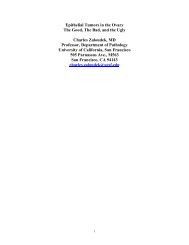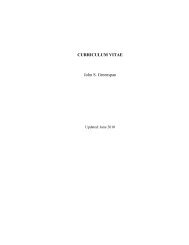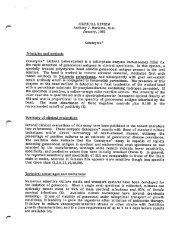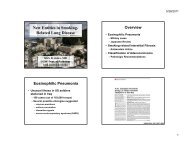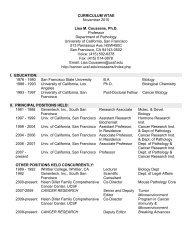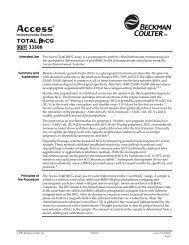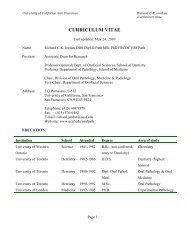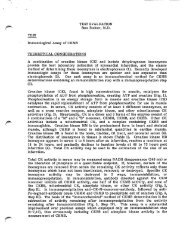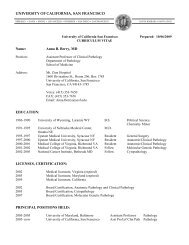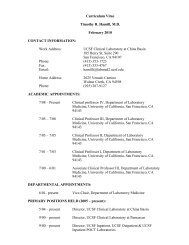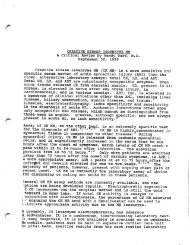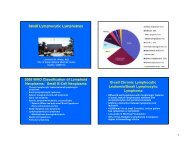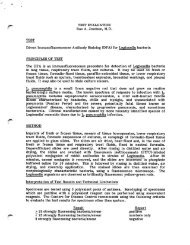Treatment Induced Changes in the Breast: Diagnosis and Staging of ...
Treatment Induced Changes in the Breast: Diagnosis and Staging of ...
Treatment Induced Changes in the Breast: Diagnosis and Staging of ...
Create successful ePaper yourself
Turn your PDF publications into a flip-book with our unique Google optimized e-Paper software.
Sampl<strong>in</strong>g Recommendations for NACT breast specimens<br />
Gross estimation <strong>of</strong> residual tumor size can be mislead<strong>in</strong>g because <strong>of</strong> stromal fibrosis. Both<br />
overestimates <strong>and</strong> underestimates <strong>of</strong> residual tumor size can occur, <strong>the</strong>refore, careful correlation with<br />
f<strong>in</strong>d<strong>in</strong>gs on histologic slides is important. Reconstruction <strong>of</strong> tumor size based on slide f<strong>in</strong>d<strong>in</strong>gs is more<br />
accurate <strong>in</strong> our experience (see below).<br />
It is important to know <strong>the</strong> pre-chemo<strong>the</strong>rapy estimate <strong>of</strong> tumor size. Tissue from across at least that<br />
dimension should be sampled from <strong>the</strong> mastectomy regardless <strong>of</strong> whe<strong>the</strong>r gross pathology is present or<br />
not. For example, if <strong>the</strong> pre-chemo<strong>the</strong>rapy tumor was 5 cm but <strong>the</strong> gross residual tumor is 2 cm, tissue<br />
should be sampled from at least 5 cm surround<strong>in</strong>g <strong>the</strong> center <strong>of</strong> <strong>the</strong> residual mass. In fact, because<br />
cl<strong>in</strong>ical/radiologic size estimates can be under-estimates, we would extend <strong>the</strong> sampl<strong>in</strong>g to beyond a 5<br />
cm size just <strong>in</strong> case microscopic tumor was present beyond <strong>the</strong> cl<strong>in</strong>ically estimated boundaries. Heavy<br />
sampl<strong>in</strong>g <strong>of</strong> marg<strong>in</strong>s is also advised, regardless <strong>of</strong> whe<strong>the</strong>r <strong>the</strong> gross appearance is suspicious or not.<br />
Measur<strong>in</strong>g Residual Tumor Follow<strong>in</strong>g NACT<br />
Tumors do not necessarily shr<strong>in</strong>k concentrically from <strong>the</strong> outside <strong>in</strong>wardly or vice versa; tumor regression<br />
can be patchy <strong>and</strong> irregular. Residual tumor may be present <strong>in</strong> one <strong>of</strong> several patterns:<br />
A dom<strong>in</strong>ant mass (usually grossly visible)<br />
Scattered nodules amongst altered stroma (usually grossly visible)<br />
Occult microscopic foci scattered amongst altered stroma (not grossly visible)<br />
Rare scattered s<strong>in</strong>gle cells (not grossly visible.<br />
This variability causes difficulty not only <strong>in</strong> measur<strong>in</strong>g residual tumor size, but also <strong>in</strong> miss<strong>in</strong>g occult tumor<br />
cells.<br />
Until <strong>the</strong> recent 7 th edition <strong>of</strong> <strong>the</strong> AJCC Stag<strong>in</strong>g System, <strong>the</strong>re were no st<strong>and</strong>ardized methods <strong>of</strong><br />
pathologically measur<strong>in</strong>g residual tumor follow<strong>in</strong>g NACT. It is not a straightforward task because <strong>of</strong> <strong>the</strong><br />
various distribution patterns that can be seen. Rely<strong>in</strong>g on radiologic size is not always accurate. Both<br />
under <strong>and</strong> overestimation can occur. For example, if a 5 cm radiologic mass is reduced to a<br />
hyal<strong>in</strong>ized, relatively acellular tumor bed which conta<strong>in</strong>s two microscopic foci <strong>of</strong> occult tumor cell clusters<br />
measur<strong>in</strong>g 0.2 cm each but separated by 3 cm, how should residual tumor size be <strong>in</strong>terpreted. Is this a 3<br />
cm tumor? Or is this microscopic residual tumor foci, measur<strong>in</strong>g up to 0.2 cm each? (an <strong>in</strong>terpretation<br />
that could be substantiated if <strong>the</strong> <strong>in</strong>terven<strong>in</strong>g 3 cm conta<strong>in</strong>s normal proliferative changes without any<br />
evidence <strong>of</strong> stromal changes <strong>of</strong> tumor regression). The cl<strong>in</strong>ical significance <strong>of</strong> <strong>the</strong> difference <strong>in</strong> <strong>the</strong>se<br />
<strong>in</strong>terpretations is unknown.<br />
AJCC Def<strong>in</strong>ition <strong>of</strong> residual tumor size: AJCC now states that <strong>the</strong> s<strong>in</strong>gle largest mass <strong>of</strong> residual <strong>in</strong>vasive<br />
cancer should be measured <strong>and</strong> used for ypT stag<strong>in</strong>g. The background fibrotic tumor bed (granulation<br />
tissue, fibrosis, organiz<strong>in</strong>g hemorrhage) should not be counted. If <strong>the</strong>re are scattered nests <strong>of</strong> tumor cells<br />
ra<strong>the</strong>r than a “mass”, AJCC states that <strong>the</strong> “largest contiguous area <strong>of</strong> <strong>in</strong>vasive carc<strong>in</strong>oma” should be<br />
measured.<br />
Recommendation: We follow <strong>the</strong> new AJCC rules, however <strong>in</strong> many scenarios it is not clear how to apply<br />
<strong>the</strong>m.<br />
Scenario 1: If <strong>the</strong>re are multiple discrete foci <strong>of</strong> residual <strong>in</strong>vasive cancer, we base AJCC ypT on <strong>the</strong><br />
largest discrete focus, but we also document <strong>in</strong> our report <strong>the</strong> total span <strong>of</strong> all <strong>in</strong>vasive foci.<br />
Scenario 2: If <strong>the</strong>re is residual <strong>in</strong>vasive cancer but <strong>in</strong>stead <strong>of</strong> a discrete focus it is present as microscopic<br />
cells or clusters distributed <strong>in</strong> a low cellularity across a large span, we base AJCC ypT on <strong>the</strong> total span <strong>of</strong><br />
<strong>the</strong> <strong>in</strong>vasive cancer. We also give a subjective description <strong>of</strong> <strong>the</strong> cellularity (i.e. scant cellularity, low<br />
cellularity, high cellularity) to dist<strong>in</strong>guish a 4 cm focus <strong>of</strong> highly cellular residual cancer from a 4 cm focus<br />
<strong>of</strong> scant residual cancer cells embedded <strong>in</strong> organiz<strong>in</strong>g fibrosis.



